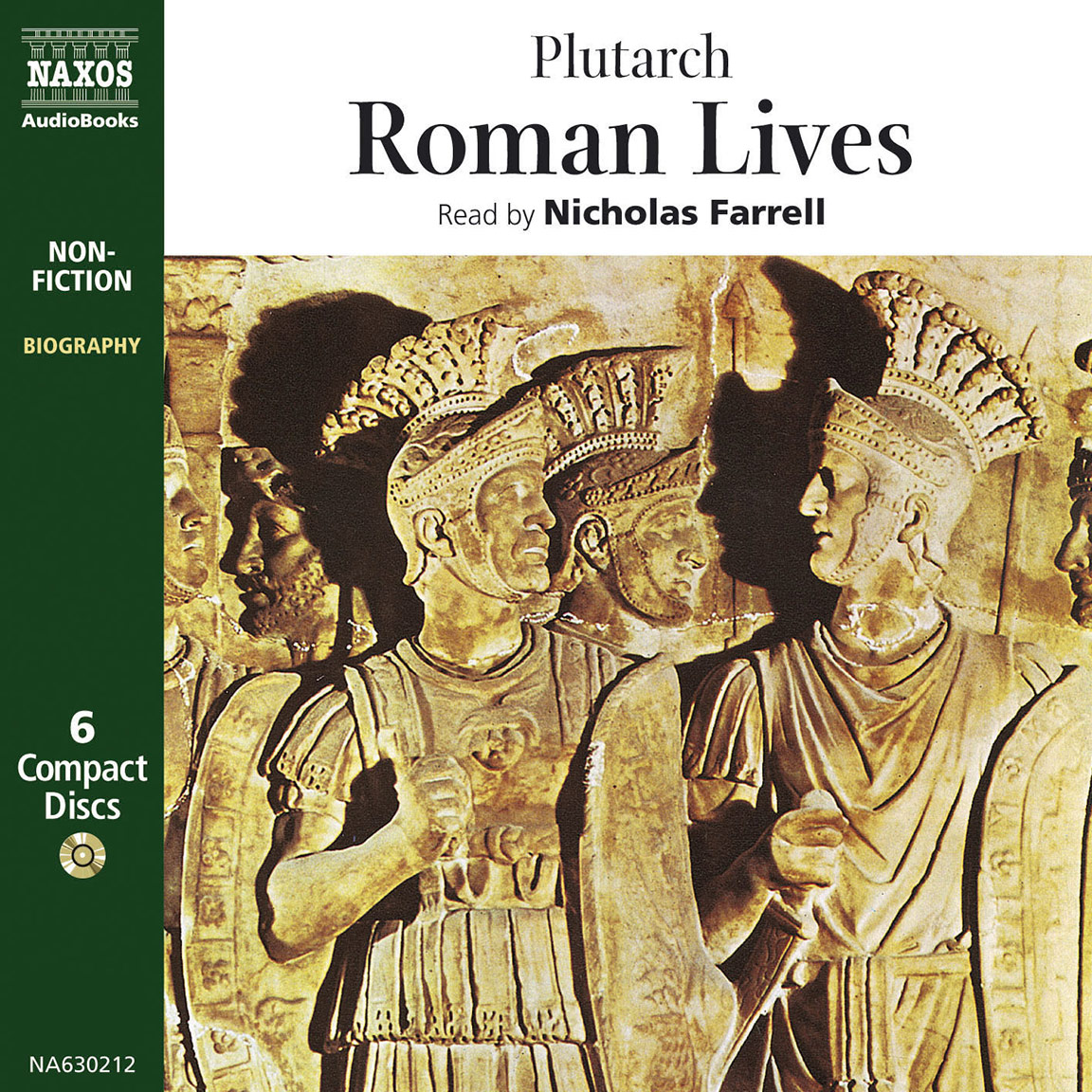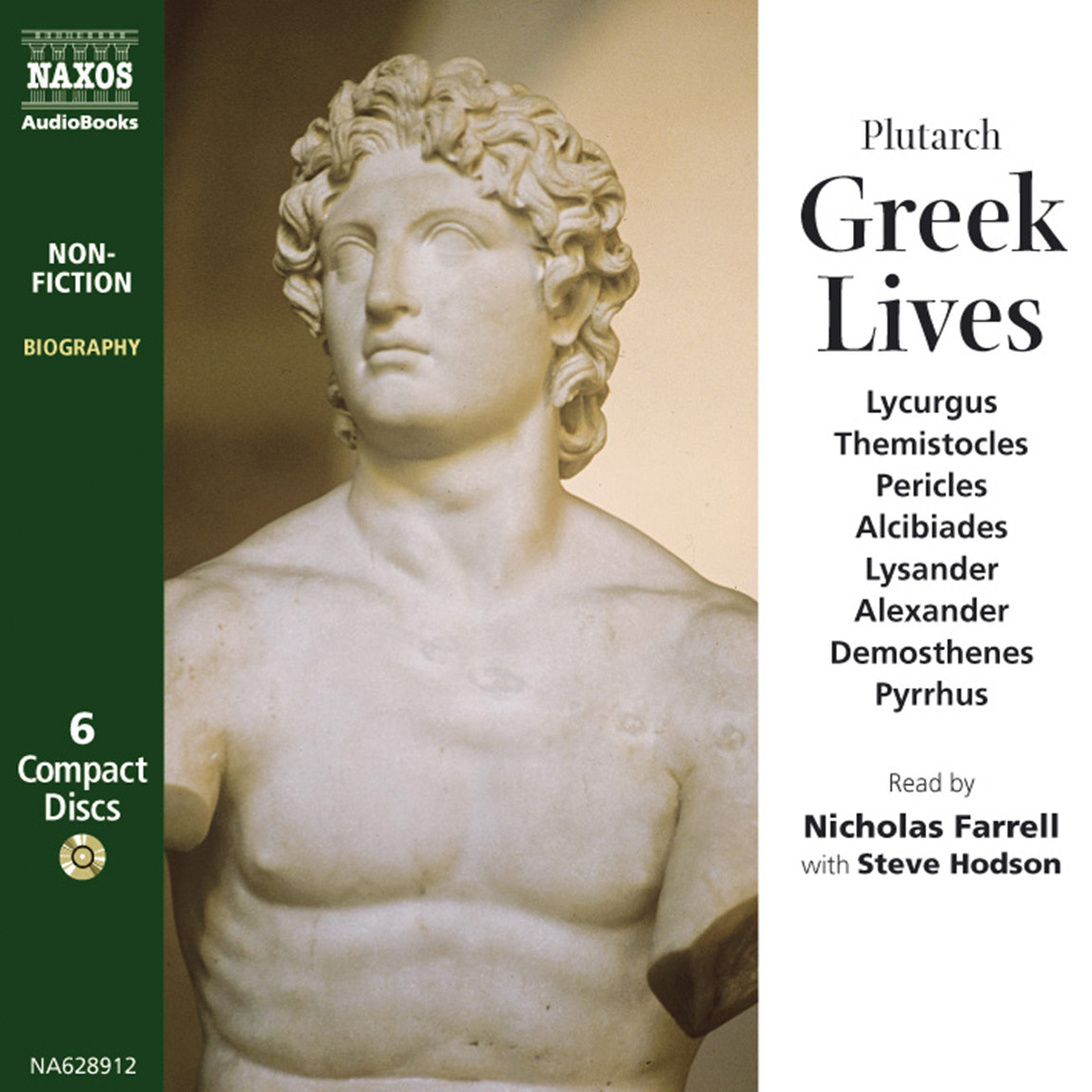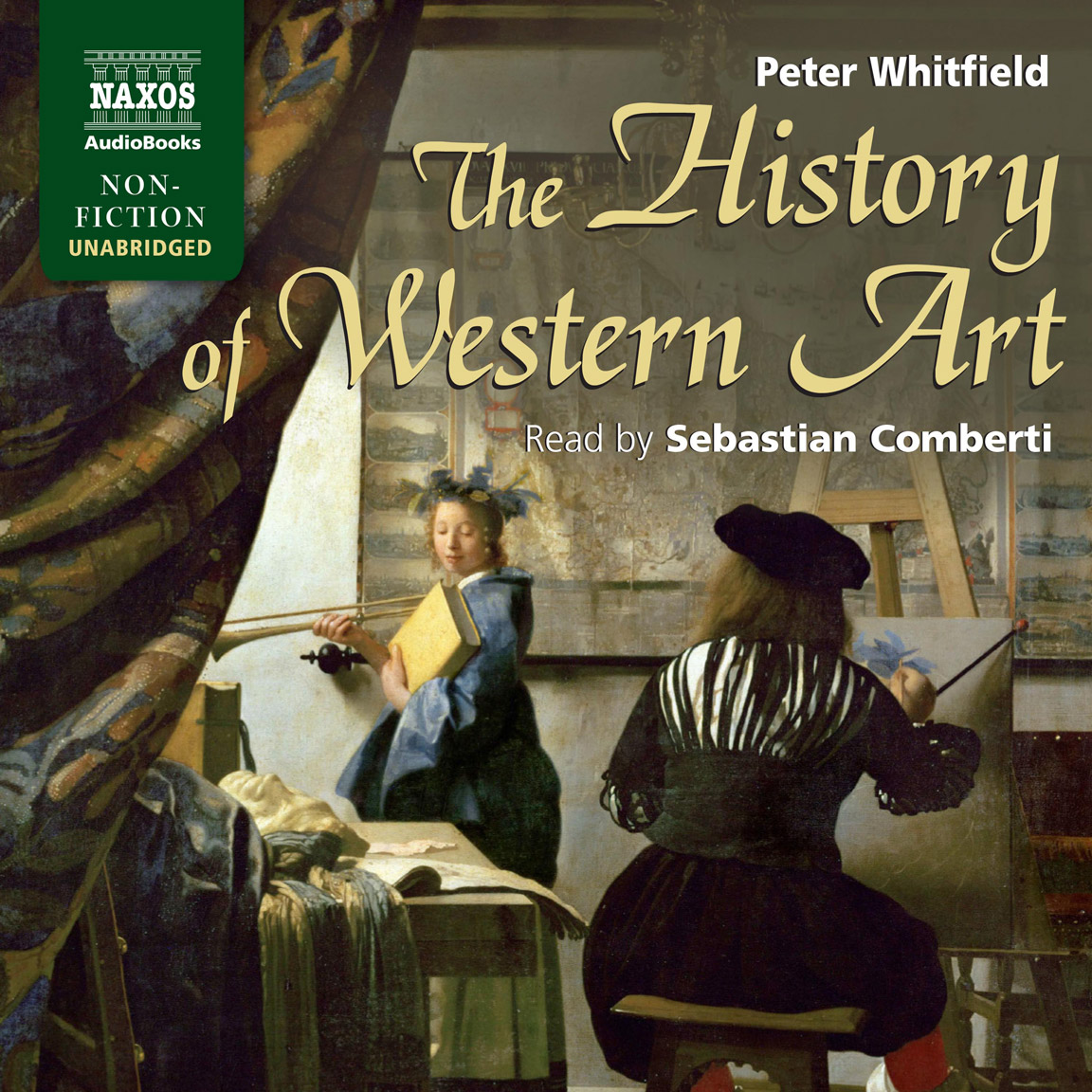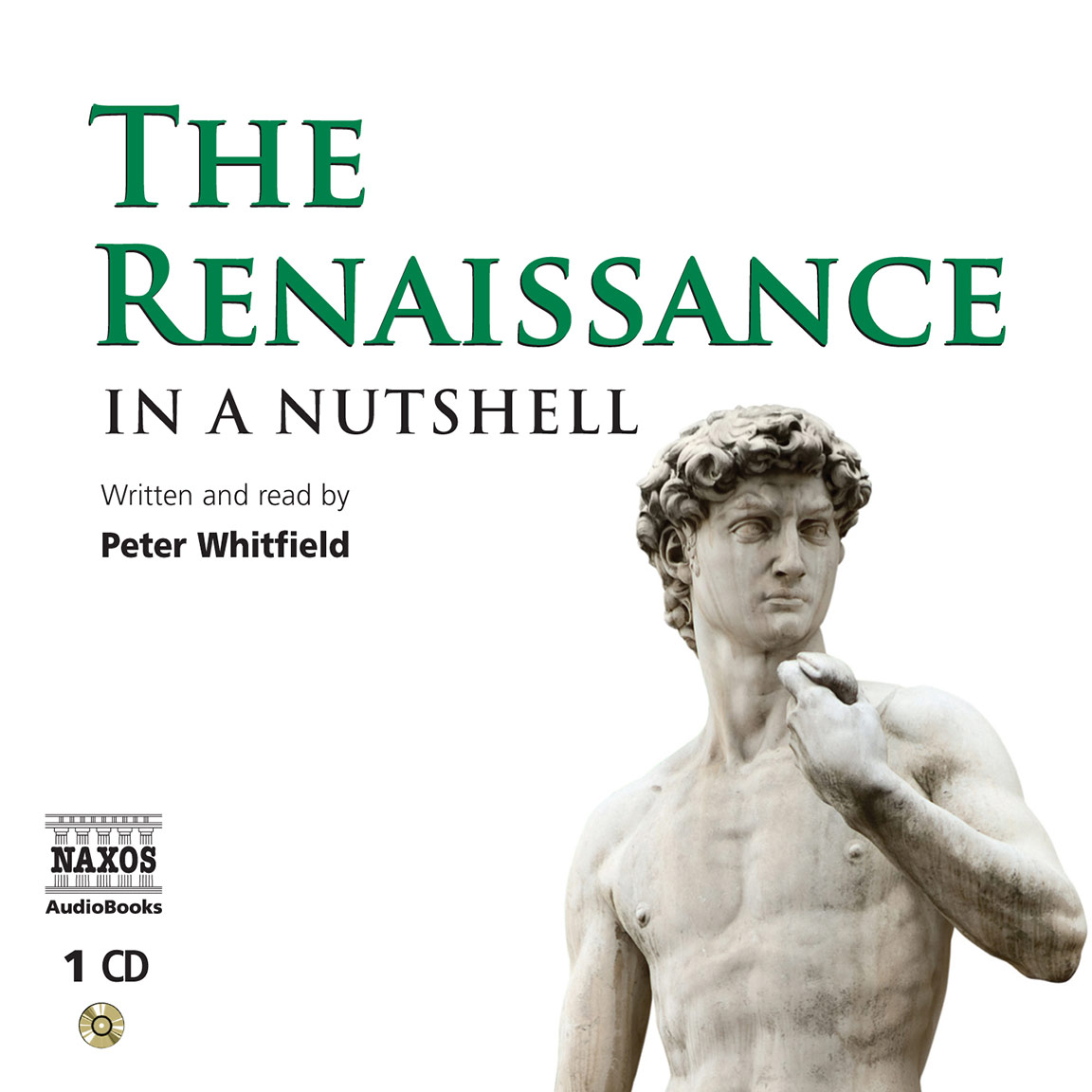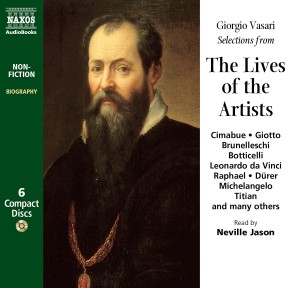
Audio Sample
Giorgio Vasari
Selections from The Lives of the Artists
Read by Neville Jason
abridged
An Italian Mannerist architect and painter, Giorgio Vasari was acquainted with many of the most famous artists of his day. He is best-known today for his biographies of artists including Leonardo da Vinci, Raphael, Michelangelo, Titian, and Giotto. This recording is read with clarity and authority by Neville Jason.
-
Running Time: 7 h 51 m
More product details
Digital ISBN: 978-962-954-756-1 Cat. no.: NA691012 Download size: 114 MB BISAC: BIO001000 Released: June 2008 -
Listen to this title at Audible.com↗Listen to this title at the Naxos Spoken Word Library↗
Due to copyright, this title is not currently available in your region.
You May Also Enjoy
Booklet Notes
‘Comes the Hour, Comes the Man’, the saying goes, and in no case is it more apt than that of Giorgio Vasari (1511–1574). His emergence at the height of the Renaissance was a remarkable and fortunate stroke of luck for the history of art. The seismic explosion of artistic creativity that was taking place in Italy during the fifteenth and sixteenth centuries cried out for a chronicler – and who better to undertake the task than someone who was not just an historian, but an artist among other artists, situated in the eye of the storm, someone whose own gifts and training gave him the ability to recognise genius when he found it, and to distinguish the greater talents from the lesser.
Vasari was a considerable artist in his own right, who earned sufficient respect and renown during his lifetime to be offered commissions to decorate and design some of Italy’s most important churches, palaces and state buildings. He was ideally placed to know the great patrons as well as his fellow artists. He was able to assess the quality of the work of his colleagues and competitors, to analyse their technical proficiency and to appreciate their imaginative invention and spiritual depth. He could recognise innovative practices when he came across them and appreciate their contribution to the progress of art. In many instances he was personally acquainted with the people about whom he was writing, either as friends, teachers, colleagues or pupils. When Vasari wrote about an artist who had died before he started The Lives, he was often able to speak to those who had known him, and note down reminiscences, apocryphal stories or just plain gossip.
But none of this would have fitted him for his task had he lacked the personal qualities necessary to carry it out. Here again he was the right man for the job. Vasari was ambitious, determined, dogged, methodical, diplomatic and, though not a natural writer, able to produce a clear narrative in a direct and personal style. What is more, by the time he was persuaded to write The Lives of the Artists, he had already been collecting information about artists and their work for some time. It would seem that he was doing so without any particular purpose in mind. Perhaps he saw it as a resource to help him further his career, whether by keeping tabs on what other artists were doing, knowing what commissions were completed and what opportunities might present themselves in the future, or as a means of measuring himself against the opposition.
He describes how the plan to write a comprehensive treatise on artists’ lives came about as the result of a conversation over dinner at the table of Cardinal Farnese. Vasari’s friend Paolo Giovio, Bishop of Nocera, a scholar and man of letters, made the suggestion to Farnese, who in turn asked Vasari whether he thought it a good idea. Vasari replied in the affirmative, but being aware that despite his learning Giovio had confused various artists, he added that he thought it would be wise for him to have someone from the profession to help him. The assembled company all urged Vasari to take on the job of assistant, and he agreed. But when, later on, he came to provide Giovio with notes, Giovio declared that Vasari was far more suited to the task than he, and persuaded him to take it on himself.
There is some doubt about the exact date of this famous dinner party, but scholars think it must have been around 1543. If this is so, it is an extraordinary feat for Vasari to have completed the work by its publication date of 1550, a period of only seven years. In fact he must have considered it finished even sooner, because it is recorded that he gave his manuscript to have a fair copy made as early as 1547, only four years after he agreed to undertake the work. What is absolutely astonishing is the number of painting commissions on which he managed to work at the same time, a tribute to his remarkable energy and devotion to the task.
Although some of the artists about whom Vasari writes were known to him personally, and it is frequently his personal contact which lends his reports their immediacy and authenticity, it would have been impossible for him to have known all. The Lives includes some 265 artists, beginning with Cimabue who died in 1302, over 200 years before Vasari was born. But he certainly knew many of the artists of his time – Titian, Signorelli, del Sarto, Salviati and Giulio Romano to mention but a few – and he corresponded with many others.
But the friendship of which he was most proud – and who shall blame him? – was that of Michelangelo. We are privileged to be able to hear from someone who was sufficiently close to the great man to have corresponded with him and to have had private conversations. Vasari quotes from their letters to each other and recounts his experience of seeing the Sistine Chapel’s Last Judgement soon after it was unveiled. It is the immediacy of such accounts which gives The Lives its unique authenticity.
In addition to collating and recording the mountains of information which make up the accounts of hundreds of artists’ lives, and as well as keeping a model workbook and detailed business records, Vasari was a prolific correspondent, and there are more than 1,000 surviving letters. His correspondents include six popes, thirty- six cardinals and an assortment of dukes, princes, high-ranking clerics, literary celebrities, artists, merchants, bankers and other people of note. As a corollary to The Lives, these documents add greatly to our knowledge and understanding of life in 16th- century Italy.
He also collected the drawings of artists he admired in his famous Libro dei Disegni, a remarkable series of volumes containing works by such luminaries as Leonardo da Vinci and Michelangelo as well as those of lesser lights, set in elaborately decorated surrounds drawn by Vasari himself. This became an invaluable source of reference for him when it came to writing The Lives. This unique document was sent to France after his death, and unfortunately split up and dispersed.
But who was Giorgio Vasari? He was born in Arezzo, a town forty miles from Florence, and baptised on July 30, 1511. Named after his grandfather, he came from a long line of craftsmen potters skilled in reproducing the black and red Attic vases for which the area was famous. This is reflected in the family’s surname, a variant of the word vasaio, or vase. Giorgio’s great-grandfather was a little-known painter by the name of Lazzaro Vasari, whom he included proudly in The Lives.
The painter Luca Signorelli was also a relative, and it was he who first encouraged Giorgio’s father to have his son trained as an artist. Another family member, Cardinal Silvio Passerini, was responsible for taking him to Florence in 1525 to further his studies. Vasari says he was apprenticed at first to Michelangelo, but as he was called away to Rome, was sent to study under Andrea del Sarto. He became a servant of the Medici, and this was the beginning of a lifelong association with the family who were to become his greatest patrons. In 1527 the Medici were expelled from Florence, and Vasari was forced to return home to Arezzo. His father had died of the plague in the meantime, and he now found himself head of the family, and obliged to shoulder new responsibilities. He spent this period struggling to provide for his mother and his brothers and sisters by decorating and restoring paintings in churches in the vicinity. In 1529 he returned to Florence, but when the city came under siege, Vasari made his escape back to Arezzo.
In 1531, after the restoration of the Medici, Cardinal Ippolito de Medici, who was travelling through Arezzo, discovered Vasari there and took him to Rome. Vasari set himself to study the work of Raphael, Michelangelo and da Vinci until illness forced him to return to Florence. He continued to serve the Medici family until the death of Ippolito, which was rumoured to have been caused by poison administered on the orders of Alessandro de Medici, who now became Vasari’s protector until he, in turn, was assassinated by his cousin Lorenzino. From this moment Vasari understandably decided to give up court life, and live independent of princely patronage. He returned to his home in Arezzo where he lived quietly, undertaking commissions from the Camaldoline monks.
After a time he returned to Florence and from there to Rome. For Vasari Rome was ‘the true school of the noble arts’. He believed that without being exposed to the highest expressions of the human spirit, even the most gifted artist would never achieve true greatness. As his reputation increased, he travelled widely to undertake various commissions in Venice, Naples, Bologna and elsewhere in Italy.
In 1550, the year the first edition of The Lives was published, Vasari took a momentous decision; he decided to get married. He did so on the advice of Cardinal Gianmaria del Monte and reports that he might never have done so but for the encouragement of the Cardinal. It would seem that Vasari was reluctant to involve himself in any activity that might distract him from his work.
He chose for a wife a young woman called Cosina, the daughter of a well-to-do Aretine apothecary. Although the match appears to have been an unromantic one, made for reasons of practicality rather than passion, it seems to have been an affectionate union, with Cosina looking after his household and, later, caring for him in his old age. The fact that they had no children was an enduring source of sadness.
In 1554 Cosimo de Medici, having finally managed to vanquish the rebel forces ranged against him, offered Vasari a place in the ducal court. Vasari, who had travelled extensively over the past years, did not wish ‘to end my days as a gypsy’ and was grateful for the opportunity of settling down in Florence with his wife and aging mother.
In 1560 he was given what was to be his most famous architectural commission. Cosimo charged him with the construction of a building between the Palazzo Vecchio and the River Arno to house the civil magistrates. This is the magnificent building we know today as the Uffizi Gallery. Like his idol Michelangelo and other artists of his time, Vasari was expected to be able to turn his hand to the design of buildings as well as to painting and sculpture, today’s strict boundary between art and architecture being unknown at that time. Having carried out this task with triumphant success he then embarked on the rebuilding and refurbishing of the Palazzo Vecchio in order to transform it into suitable living quarters for the Medici family.
Vasari was influential in the foundation of the Academy of Design in Florence in 1563. As he remarks in The Lives, the existence of the recently-formed Academy was a great boon the following year when, on the death of Michelangelo, its members combined to produce funeral obsequies of extraordinary creativity and magnificence to honour the great man.
In addition to his heavy workload as a painter and architect, Vasari found time to amend, rewrite and add to The Lives with a view to producing a new edition, despite having to interrupt its preparation for periods of other work sometimes lasting several months. The revised edition appeared in 1568, and was nearly three times as large as the previous one. It included a separate new volume dedicated to artists working between the publication of the first and second editions. Relations between the Medici family and Rome were becoming normalised once more, and in 1570 Vasari was given three chapels to decorate in the Vatican by Pope Pius V, and a series of frescoes in the Sala Regia. At the same time he was working on his designs for the cupola of the cathedral in Florence, which he had started to paint. By 1574 his health was failing and he was no longer able to climb the scaffolding to reach the interior of the dome, and had to be pulled up in a basket. In April that year his old patron Cosimo de Medici died, and on June 27 Vasari followed him.
If Vasari’s painting lacks the spontaneity and magical transcendence of true genius, it cannot be said to fall short due to lack of effort. As Malvolio says, ‘Some are born great, and some achieve greatness…’ Vasari used what gifts he had to the full, and achieved as much as it is possible to achieve through natural skill, hard work and application. His passionate interest in his subject, and his ability to learn from the best examples, allowed him to triumph over others more talented who lacked his tenacity and dedication.
The same might be said of his literary achievement. He was not a natural writer, but he leaves behind him a record which is wonderfully entertaining, due to his enthusiasm and his appetite for knowledge. However conventional his viewpoint or his manner of expressing it, and despite his occasional pomposity or partiality, the essential decency of his personality shines through. Although he reports the intrigues and envious behaviour of other artists – sometimes with a gossip’s relish – there is little or no malice to be found in his own attitude.
Vasari’s achievement is the result of the power of his ambition. Ambition for him was not something of which to be ashamed, but a quality to be celebrated and admired, an honourable spur to the highest attainment. As an artist, his efforts brought him honour, respect and prosperity; as an historian and critic, his work has earned him eternal fame.
Vasari’s The Lives of the Artists is unique in its scope and achievement. Its only classical predecessor and model is Pliny’s Natural History, but there was no previous model for artistic biography on such a scale. Modern scholars with access to documents that were unavailable to Vasari have discovered many inaccuracies in facts and dates, but what is extraordinary, given the circumstances in which he lived and the exigencies of his working life, is not how much he got wrong, but how much he got right.
The Lives remains the greatest source of knowledge and understanding of the artistic life of the Renaissance available to us and to generations yet to come. Perhaps the finest tribute to Vasari is the following sonnet, written in appreciation of The Lives by the artist he admired above all others, Michelangelo:
With pencil and with palette hitherto
You made your high art Nature’s paragon;
Nay more, from Nature her own prize you won,
Making what she made fair more fair to view.
Now that your learned hand with labour new
Of pen and ink a worthier work hath done,
What erst you lacked, what still remained her own,
The power of giving life, is gained for you.
If men in any age with Nature vied
In beauteous workmanship, they had to yield
When to the fated end years brought their name.
You, re-illuminating memories that died
In spite of Time and Nature have revealed
For them and for yourself eternal fame.
Neville Jason

